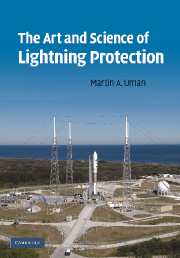Book contents
- Frontmatter
- Contents
- Preface
- 1 What is lightning?
- 2 Lightning damage
- 3 General methods for lightning protection: Faraday cages, topological shields; and more practical approaches: cone of protection and rolling sphere methods
- 4 Structure protection: air terminals and down conductors
- 5 Structure protection: grounding
- 6 Surge protection for electronics in low-voltage electrical systems
- 7 Humans and animals
- 8 Lightning warning
- 9 Airships, airplanes, and launch vehicles
- 10 Ships and boats
- 11 Trees
- 12 Overhead and underground power and communication lines
- 13 Lightning elimination
- 14 So, what do we know and what don't we know about lightning protection?
- Index
- References
11 - Trees
Published online by Cambridge University Press: 17 November 2009
- Frontmatter
- Contents
- Preface
- 1 What is lightning?
- 2 Lightning damage
- 3 General methods for lightning protection: Faraday cages, topological shields; and more practical approaches: cone of protection and rolling sphere methods
- 4 Structure protection: air terminals and down conductors
- 5 Structure protection: grounding
- 6 Surge protection for electronics in low-voltage electrical systems
- 7 Humans and animals
- 8 Lightning warning
- 9 Airships, airplanes, and launch vehicles
- 10 Ships and boats
- 11 Trees
- 12 Overhead and underground power and communication lines
- 13 Lightning elimination
- 14 So, what do we know and what don't we know about lightning protection?
- Index
- References
Summary
General
Trees are protected in much the same way that structures are protected, with the added provision that lightning current must not be allowed to flow in the major root system. Current in the major tree roots can result in root damage that leads to the death of the tree. Grounding of the lightning current is therefore best accomplished by locating the primary grounding electrodes, ground rods and/or buried horizontal wires, near the outer edge of the branches where there are few significant roots. NFPA 780:2004 contains an Appendix, called Annex F, discussing the protection of trees, and the American National Standard Institute document, ANSI A300 (part 4: 2002), provides similar information and some additional information regarding the protection of specific types of trees.
According to NFPA 780:2004, all trees with trunks within 3 m (10 feet) of a structure or with branches that extend to a height above the structure should be protected. The three primary reasons for the NFPA-recommended protection are to avoid damaging side flashes (see Section 4.4) from the tree to the structure (the ground electrode of the tree is to be bonded to the structure protection system), to avoid a tree fire that could presumably spread to the structure, and to avoid the explosive and potentially damaging splintering of the tree due to the superheating of the moisture in the tree (see Section 11.3).
- Type
- Chapter
- Information
- The Art and Science of Lightning Protection , pp. 186 - 198Publisher: Cambridge University PressPrint publication year: 2008



